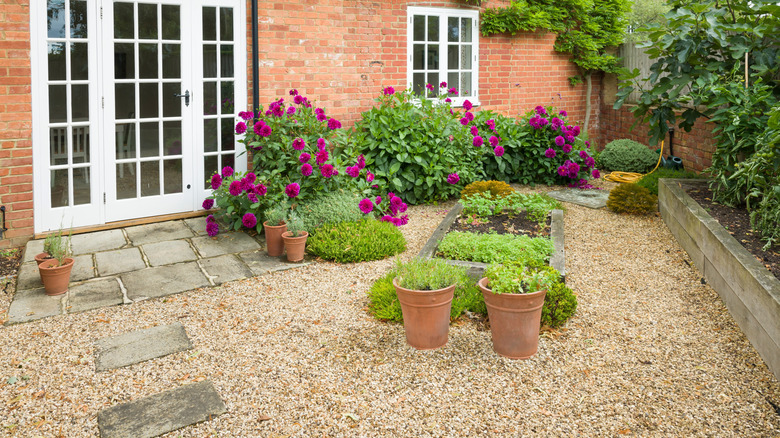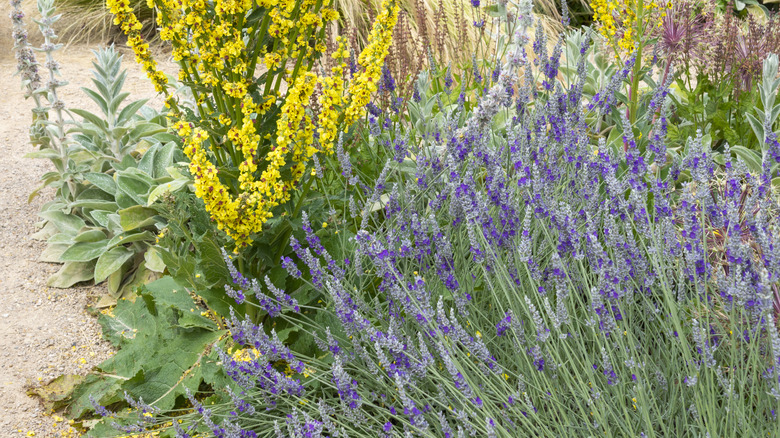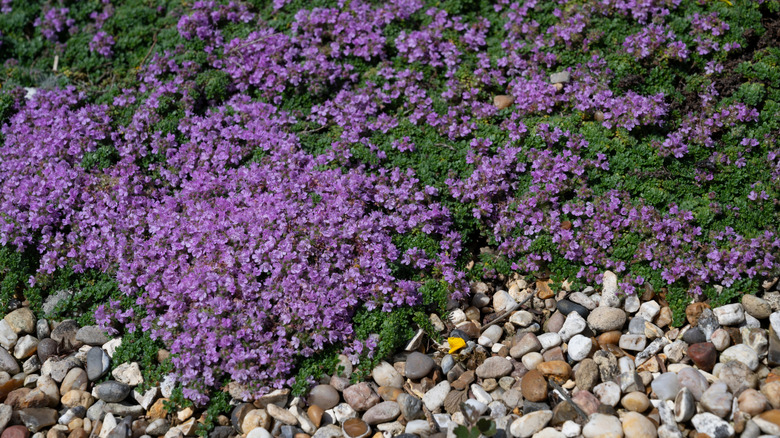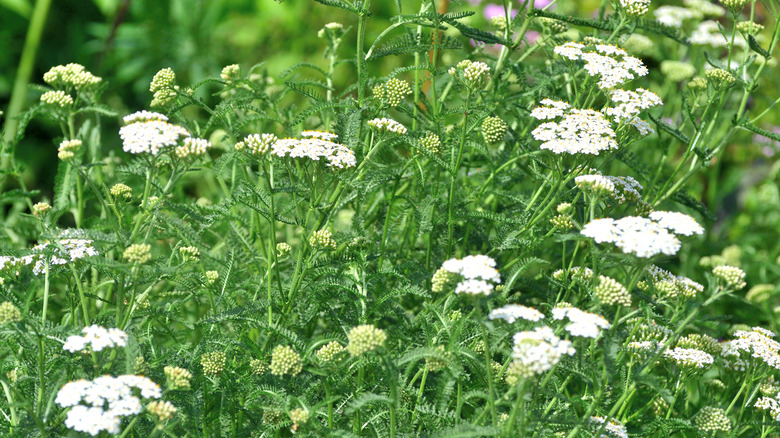Easy-To-Grow Herbs That Are Perfect For Gravel Gardens
Some gardeners love to be in the dirt every day, while others prefer to be more hands-off, enjoying their garden's sights and smells from a walkway or bench. If you're in the latter category, a gravel garden is ideal. Typically, gravel gardens are installed in sunny areas with sandy soil, featuring vegetation that requires little maintenance in this environment.
A wide range of drought-tolerant plants with deep roots can grow well in gravel gardens, from bulbs to wildflowers to grasses. As far as herbs go, look for those that are native to the Mediterranean, since they tend to prefer well-draining, sandy soils and dry conditions. Many familiar and easy-to-grow culinary herbs thrive in gravel gardens, including lavender, rosemary, thyme, and oregano.
If you're a hands-in-the-dirt-type gardener, a low-maintenance gravel garden is still a great way to fill extra yard space that's too dry, rocky, or poor in nutrients to support most edible or ornamental plants. In simple terms, gravel gardens comprise a layer of gravel on top of soil. The aggregate works similarly to a mulch or ground cover by improving drainage and suppressing weed growth. These gardens require regular watering for the first year or two as the plants' roots grow deep enough to reach the soil. But by the third year, they are about as hands-off as you can get. Depending on the weather conditions and the plants you're growing, your garden may need no extra watering or fertilization.
Lavender and rosemary
Gravel gardens are an ideal setting to keep lavender healthy, especially in humid areas where the roots may otherwise struggle. Lavender thrives in sandy or rocky soil that's technically considered "poor," but to a lavender plant, is the perfect place to call home. The most common variety is English lavender (Lavandula angustifolia), but there's also French lavender (Lavandula x intermedia) and Spanish lavender (Lavandula stoechas). English and French lavenders are hardy in USDA zones 5 to 9, while Spanish lavender is hardy in zones 7 to 9. Lavender doesn't require much maintenance, especially in a gravel garden. Just prune it annually after flowering is complete in the spring and summer, and don't cut into older, woody growth unless it's dead or diseased.
Rosemary (Rosmarinus officinalis) is a great companion plant for lavender and an ideal candidate for gravel gardens in general. Both rosemary and lavender can be used as a hedge or a border, and both are Mediterranean natives with similar care requirements. Rosemary blooms later in the year than lavender, creating variety and interest in your garden throughout different seasons. And, like lavender, the only necessary maintenance for rosemary is pruning it annually to maintain its bushy shape, prevent straggly stems, and keep its size in check. Some varieties climb or trail while others grow upright. It's best to replace a rosemary plant every five years or so; you can use cuttings from the original plant. Rosemary is cold hardy in USDA zones 8 to 11.
Thyme and oregano
When you think of thyme, you probably think of the kind that's most often in the seasoning aisle (Thymus vulgarus). But there are tons of types of thyme to choose from, each with different flavors and fragrances. Some, such as creeping thyme (Thymus serpyllum), are grown as ornamental ground covers rather than as harvestable herbs. Regardless, these plants smell lovely and are low-maintenance, doing well in poor soils and drought-like conditions. If you're growing an edible thyme in your gravel garden, you can harvest it year-round, but the flavor is best in the summer. Use the fresh leaves for cooking or dry them for later. Maintenance-wise, just trim thyme when it's leggy; you may need to replace it after a few years as it becomes woodier. Common thyme is hardy in zones 5 to 9.
Greek oregano (Origanum vulgare hirtum) is another Mediterranean herb that will feel right at home in a gravel garden with poor soil. This plant's delicious leaves can also be used fresh or dried and are featured in a wide range of dishes. Harvest them in the spring or summer; it's best not to let your oregano flower to keep the leaves as yummy as possible. Oregano is hardy from zones 4 through 11. It may need partial shade in hotter environments, but otherwise, this herb requires full sun. Trim it regularly to encourage bushy growth rather than legginess.
Yarrow and beyond
Aside from Mediterranean plants, native prairie plants are your best bet for gravel gardens since they also tend to be highly drought tolerant. One medicinal herb that falls into this category is common yarrow (Achillea millefolium), a native plant that is commonly found in the wild and comes in many colors. Yarrow is often used as a homeopathic remedy for a variety of ailments, from bug bites and eczema to illness. It prefers full sun, dry conditions, and well-draining soil, and it may need supplemental watering if you get less than an inch of water per week in the summer. Yarrow is also quite an aggressive grower that spreads quickly. Cut off spent flowers and divide the plant every few years. Yarrow is hardy in zones 3 to 9.
Other native, traditional herbs that grow well in gravel gardens include bee balm (Monarda bradburiana) and pale purple coneflower (Echinacea pallida). Bee balm was traditionally used to soothe bites or stings, while echinacea is found in many over-the-counter herbal supplements for infections. There are many other non-native, drought-tolerant herbs to choose from as well, including marjoram, sage, fennel, juniper, and catmint, all of which are hardy enough to thrive in your low-maintenance gravel garden.



